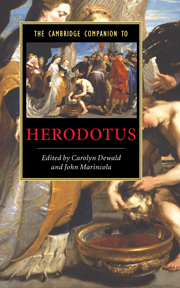Book contents
- Frontmatter
- Introduction
- 1 Herodotus and the poetry of the past
- 2 Herodotus and his prose predecessors
- 3 Herodotus and tragedy
- 4 The intellectual milieu of Herodotus
- 5 Meta-historiē: Method and genre in the Histories
- 6 The syntax of historiē: How Herodotus writes
- 7 Speech and narrative in the Histories
- 8 Herodotus, Sophocles and the woman who wanted her brother saved
- 9 Stories and storytelling in the Histories
- 10 Humour and danger in Herodotus
- 11 Location and dislocation in Herodotus
- 12 Herodotus and the natural world
- 13 Herodotus and Greek religion
- 14 Warfare in Herodotus
- 15 Herodotus, political history and political thought
- 16 Herodotus and the cities of mainland Greece
- 17 An alternate world: Herodotus and Italy
- 18 Herodotus and Persia
- 19 Herodotus and foreign lands
- 20 Herodotus' influence in antiquity
- Glossary
- Timeline
- Bibliography
- Index
- Series List
6 - The syntax of historiē: How Herodotus writes
Published online by Cambridge University Press: 28 January 2007
- Frontmatter
- Introduction
- 1 Herodotus and the poetry of the past
- 2 Herodotus and his prose predecessors
- 3 Herodotus and tragedy
- 4 The intellectual milieu of Herodotus
- 5 Meta-historiē: Method and genre in the Histories
- 6 The syntax of historiē: How Herodotus writes
- 7 Speech and narrative in the Histories
- 8 Herodotus, Sophocles and the woman who wanted her brother saved
- 9 Stories and storytelling in the Histories
- 10 Humour and danger in Herodotus
- 11 Location and dislocation in Herodotus
- 12 Herodotus and the natural world
- 13 Herodotus and Greek religion
- 14 Warfare in Herodotus
- 15 Herodotus, political history and political thought
- 16 Herodotus and the cities of mainland Greece
- 17 An alternate world: Herodotus and Italy
- 18 Herodotus and Persia
- 19 Herodotus and foreign lands
- 20 Herodotus' influence in antiquity
- Glossary
- Timeline
- Bibliography
- Index
- Series List
Summary
He invested his style with all the qualities that his predecessors had failed to acquire.
Dionysius of Halicarnassus, De Thuc. 5Herodotus is an unaccountable phenomenon in the history of literature.
J. D. Denniston, Greek Prose StyleHerodotus' Histories is a work of startling originality; there are no preexisting categories that capture the work's multifaceted nature. It can be read as historiography (tragic and epic, universal and local), ethnography, geography, oracular warning, and much more. To see the work in terms of any of these genres to the exclusion of others would be an arbitrary reduction of the whole to one of its component parts. And to see it as an 'early' instance of any of them would create a retrojection of modern assumptions that would exclude much of the living text's multifaceted reality. What would be lost is the context for which it was originally designed. Herodotus may write for posterity, but he practises historiē - his own unique kind of investigation into the world he inhabits - on his own terms.
What applies to the context of Herodotus' ambitious project of historiē is no less true of its style. Herodotus' own term for his discourse is logos. Epic and prosaic, colloquial and elevated, oral and literate, Herodotus' discourse defies categorisation just as much as content does. Indeed, to make a distinction between the context and its 'style', or between Herodotus' investigations and their linguistic articulation, is misleading. Historiē, the quest for the 'cause' of the conflict between Greeks and barbarians, is achieved in and through the logos that Herodotus presents to us.
- Type
- Chapter
- Information
- The Cambridge Companion to Herodotus , pp. 92 - 102Publisher: Cambridge University PressPrint publication year: 2006
- 22
- Cited by



